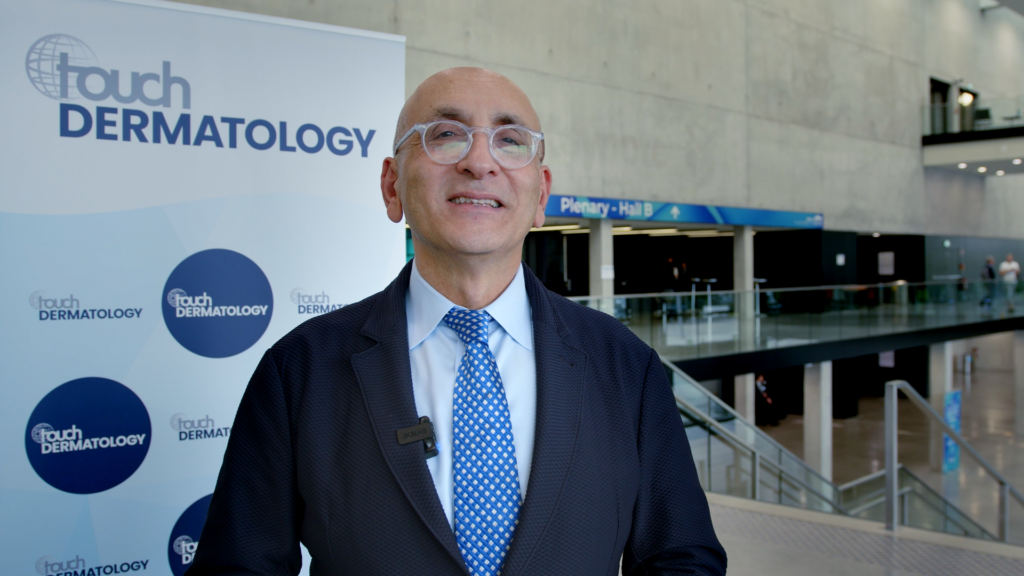Effisayil 1 (NCT03782792) was a randomised, double-blind, placebo-controlled phase 2 study that investigated the efficacy and safety of spesolimab in generalized pustular psoriasis (GPP). touchIMMUNOLOGY were delighted to speak with Dr. Claudia De La Cruz (Clínica Dermacross, Santiago, Chile) to discuss the aims, design and findings from Effisayil 1 and the impact spesolimab has already had on the treatment paradigm for GPP following approval.
The abstract ‘Efficacy and safety of spesolimab for generalized pustular psoriasis treatment according to flare trigger.‘ (Poster ID: 43751) was presented at AAD 2023, 17-21 March, 2023.
This information is brought to you by Touch Medical Media and is not sponsored by, nor a part of, the AAD.
Questions
- Could you give us a brief overview of pustular psoriasis, what factors are reported to trigger flares and its clinical presentations? (0:16)
- What is the mechanism of action of spesolimab? (0:49)
- What impact has spesolimab already had on the treatment paradigm for generalized pustular psoriasis? (1:26)
- What were the aims and design of the Effisayil 1 study? (2:25)
- What were the primary and secondary endpoints and how well were they achieved? (3:17)
- How will these insights optimise the use of spesolimab in clinical practice? (4:52)
Disclosures: Claudia De La Cruz discloses receiving grant/research support from Abbvie, Pfizer, Janssen, Amgen, Boehringer ING, UCB, and Novartis; serving on advisory boards for Boehringer, Abbvie, Novartis, and Eli Lilly and participating in speaker’s bureaus with Abbvie, Novartis, and Lilly.
Support: Interview and filming supported by Touch Medical Media Ltd. Interview conducted by Victoria Jones.
Filmed in coverage of the 2023 AAD Annual Meeting.
Click here for more content on dermatological conditions.
Transcript
Could you give us a brief overview of pustular psoriasis, what factors are reported to trigger flares and its clinical presentations? (0:16)
Well GPP is a very rare neutrophilic skin disease that is characterized by recurrent episodes of sterile pustules, widespread sterile pustules that can occur with or without systemic inflammation. The factors that are reported to trigger GPP flares include the treatment discontinuation, medication, infection and stress.
What is the mechanism of action of spesolimab? (0:49)
Well, the mechanism of action is binding of the spesolimab to IL-36 receptor prevents the subsequent activation of IL-36 receptors by cognate ligands IL-36 alpha, beta and gamma and downstream activation of proinflammatory and pro-fibrotic pathways. The precise mechanism linking the reduced IL-36 activity and the treatment of flares of GPP is still unclear.
What impact has spesolimab already had on the treatment paradigm for generalized pustular psoriasis? (1:26)
I would say that the most important impact is that for the very first time for such a threatening disease like GPP, which is life threatening for our patients for the first time, we have a specific treatment for this condition. The impact on the quality of life of these patients, it’s really enormous. I mean, these are patients that have had to be frequently hospitalized, they get erythroderma, they get very, very ill. Sometimes they have to be managed by the ICU units and these are very severe form of psoriasis. So, the impact, it’s really amazing because for the first time, as I was saying, for the very first time, we’re having treatment specifically targeting GPP.
What were the aims and design of the Effisayil 1 study? (2:25)
Well, the aim was to understand the efficacy and the safety of spesolimab in the treatment of GPP flares, in patients whose flares were triggered by intrinsic or extrinsic factors and to understand the differences in patient characteristics based on GPP flare trigger. We understand by intrinsic factors those defined as stress, infection or other, for example, patient’s own disease condition, fatigue, cold sores and treatments, for example. Those are the intrinsic factors and for the extrinsic factors we define them as to treatment withdrawal, steroid withdrawal or other, for example, the dose reduction of any other medication.
What were the primary and secondary endpoints and how well were they achieved? (3:17)
The primary endpoint was GPPGA pustulation subscore of zero, which means no visible pustules at week one and the key secondary endpoint was a GPPGA total score of zero or one, which is clear or almost clear skin at week one. So, what we found out of this study is that the spesolimab dose of 900 milligrams intravenous was more effective for both groups intrinsic and extrinsic factors reaching 50 and 53% of our patients for the primary endpoint. For the key secondary endpoint, the same, spesolimab 900 milligrams intravenous it showed 50% efficacy, over 20% placebo in the patients for the intrinsic trigger group and the same almost the same 53.3% for the extrinsic trigger groups versus the placebo group, which only reached 10%. So in both groups for the primary and secondary endpoint, in both intrinsic and extrinsic triggers, we found out that the dose of spesolimab 900 milligrams intravenous was very effective in treating the GPP flare.
How will these insights optimise the use of spesolimab in clinical practice? (4:52)
Well, I think that this is going to be extremely useful medicine for the treatment of these GPP flares, because, as we were mentioning, this is a life threatening disease. To have a patient being treated properly at an early stage of this disease, it’s going to help us have our patient recover from this flare very fast, very quickly, and be inserted in their common life very soon. Because what we see right now is that these patients are not treated properly, are not treated early in the disease, and they stay in ICU units for a very long time. They are not getting the proper treatment and so the recovery is very, very slow so they cannot reinsert in their common life, in social life, in work life very soon. So, I think this is going to be life changing for these patients.
Subtitles and transcript are autogenerated.










